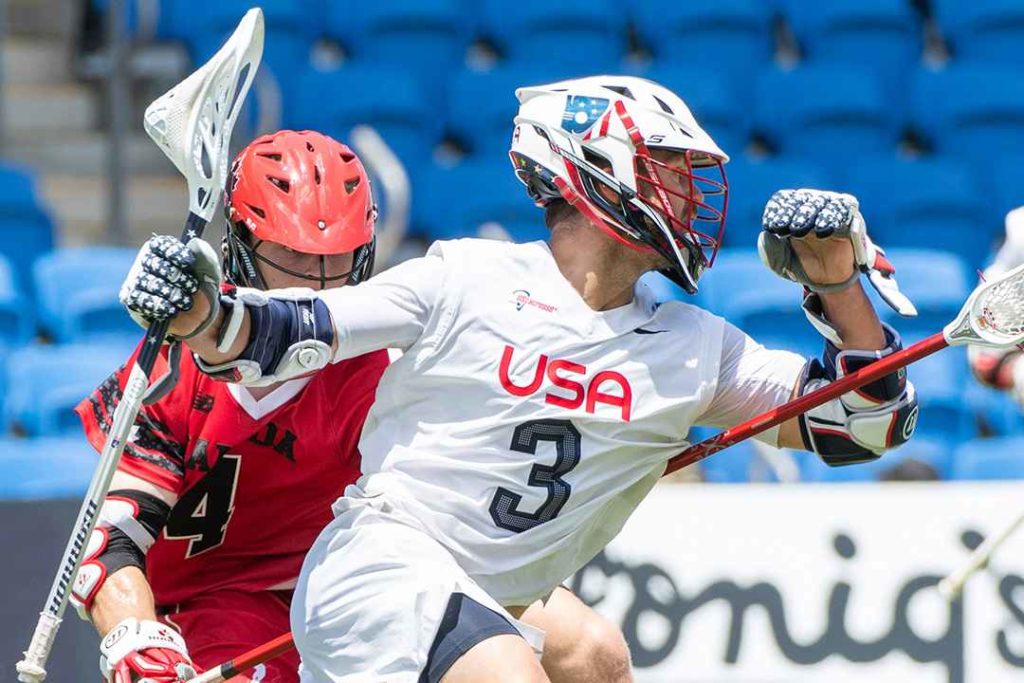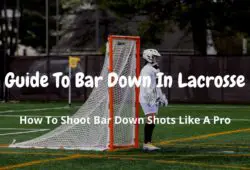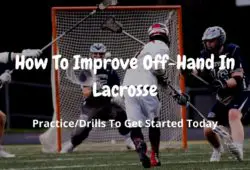Learning how to dodge in lacrosse and get away from defensive players is the most important step toward becoming a successful offensive player. It allows you to get open to shoot a powerful and quality shot. Also, it makes you an unpredictable offensive player who is harder to defend.
In lacrosse, there are five common and broad categories of dodges that players capitalize on. In this post, we will walk through them in detail with illustrations and key takeaways.
What’s dodging in lacrosse
As an offensive player, you often find yourself surrounded by defenders. Your job is to get in front of the goal meanwhile your opponent is trying to interfere and push you off the course. Hence, dodging plays an important role in getting past defenders and making room for yourself.
It combines footwork, core strength and stickwork. The common misconception is dodging is about making preconceived moves; but in reality, you are making a read on the defender and waiting for the right opportunity to adjust.
Now let’s explore the different dodges that could make you a versatile and threatening player.

Split Dodge
The most popular and common dodging technique is the split dodge. It’s performed by fast speed and deceptive hand moves. With a basic stick skill and an unbeatable speed, you force your opponent to make mistakes.
Sprinting toward your opponent, notice if the defender is squared up to you and not pushing you in a certain direction, move to one side. As soon as your opponent opens up his/her hip, switch from non-dominant hand to dominant hand across your body. Meanwhile, change to the direction of your dominant hand.
The name “split” stems from the idea while you are making a directional change, you are also switching hands. The top hand shifts to the bottom end of the shaft and the bottom hand shifts to the top end of the shaft.
After successfully executing the dodge, you will have opportunities to shoot from the middle or the sides, or quickly feed it to your teammate in front of the goal.
Takeaways: there are two key takeaways when using split dodge to your advantage:
1. Plant your foot hard on the split
To deceive your opponent, you must make the first step to one side convincing, which manipulates the defenders into going the wrong way. So make sure to extend your foot and plant it to the ground as if you are going in that direction.
2. Keep your feet moving
Notice how Paul keeps his feet moving at all times. To outcompete your defender, your feet have to be quicker than theirs. As soon as you slow down, your defender will match with your pace and throw you a check.
Roll Dodge
This is also a pretty common dodge you see players utilize, specifically the inside roll dodge. The idea of a roll dodge is to “roll” past your defender into your dominant hand. If you are left-handed and moving down the right-wing, a roll dodge can get you open to the left side with a quick left-handed opportunity.
As you run toward the defender, drive yourself into your opponent. Once you are in close proximity to the defender, take a step with your right foot and push yourself off as you change to the left and roll around your defender. When making the spin move, keep your stick close to your body for maximum stick protection.
The roll dodge is very effective at protecting the ball against long pole defensemen that could reach a larger clearing area.
Takeaways: Two key points from the video above
- Execute the dodge when the defender is pushing you to one side
Players choose to execute roll dodge when defensive players are playing aggressively and pushing you to one side. This is the best opportunity to roll around your defender to either the middle of the field or the alley.
- Spin yourself as fast as you can
Once you commit to a roll dodge, you have to follow through. Plant your foot into the ground, and pivot your body as fast as you can toward the other side of your opponent. To successfully perform a roll dodge requires determination.
Face Dodge
Unlike split and roll dodges above, face dodge requires a subtle deception to move past defenders. When you receive a pass from a teammate and are ready to take a shot from your position, notice the position of your defender. If s/he is sprinting toward you to make a final interception, the chances are they are closing in too aggressively.
Quickly pull back your shot and bring in your stick across your face to hold the ball. Once you pass the defender, take the shot.
The difference between a face dodge and a split dodge is changing hands. Face dodge doesn’t switch hands. You execute face dodge entirely with the same hand placement.
Takeaways:
- Face dodge is all about deception.
Placing yourself in a shooting stance is the best way to deceive your defender. As soon as you identify an opportunity where your defender is coming at you too aggressively, bait your defender with a fake shot.
- Look to shoot or feed immediately after
Once you move past the defender, someone else will come to close you out. So to not give them a chance to land you a check, you must quickly make a decision to shoot for a goal or pass to your teammate.
Bull Dodge
If you are a power player with great strength, bull dodge will give you an edge over the opponent. Bull dodge is all about making contact and moving past your opponent using force. Especially if the defender is smaller in size, you can outmuscle him by executing a bull dodge.
The idea is by making physical contact against the opponent, you create space between. Hoping as you push your way in, the defender wears out and gives up his position.
Before you pick bull dodge as your choice of dodging, double check if bull dodge is legal in your league. In the professional league, referees allow bull dodge so long as offensive players lower their shoulders into defenders.
Women and youth levels deem bull dodge illegal.
Question Mark Dodge
Last but not least, I want to include an advanced dodging technique that is also very effective but requires a bit more skill. To master the question market dodge, you need to spend more time practicing by yourself and with a partner.
Some players draw similarities between a question market dodge and an inside roll dodge. The difference lies in the direction of the pivot. Inside roll dodge pivots the player to the middle in front of the goal. Question mark dodge pivots the player away from the goal for an immediate shot.
Once you find yourself 4-5 yards up and away from the goal, you lean into the defender, plant your foot that’s closer to the goal and quickly spin outward to the other direction. This dodge is named after the fact you are making a shape of a question mark when making the dodge. Also, remember to switch hands when spinning yourself to face the goal before shooting.
Takeaways:
- Set up a question mark dodge
From the video, you can see 99% of question market dodges happen near a similar spot, 4-5 yards up and away from the goal.
The reason why this is important is to leave a sufficient angle after your spin to shoot at the goal. If you left yourself without a proper angle, it’s very easy for the goalie to block your shot.
- Drive the opponent deep into one side
Leaning yourself into the defender pushes the defender to move sideways to one side. Then plant your foot and quick spin outward to create room to land a shot.
Expand your arsenal of dodging techniques

Now we know the most popular and common dodging techniques. If you haven’t done so, be sure to pick and choose a select few that suit your play style and preference. Instead of learning all of them, you should focus on mastering two or three.
What elite players do is combine dodges to make themselves even more deadly and much harder to defend. By dodging in combinations, you create more opportunities to let defenders make mistakes thereby creating more offensive chances for you.
The goal of performing dodges is to move pass defense and get open to take shots or to feed. So when you practice dodging, be sure to also practice the follow-through after.




